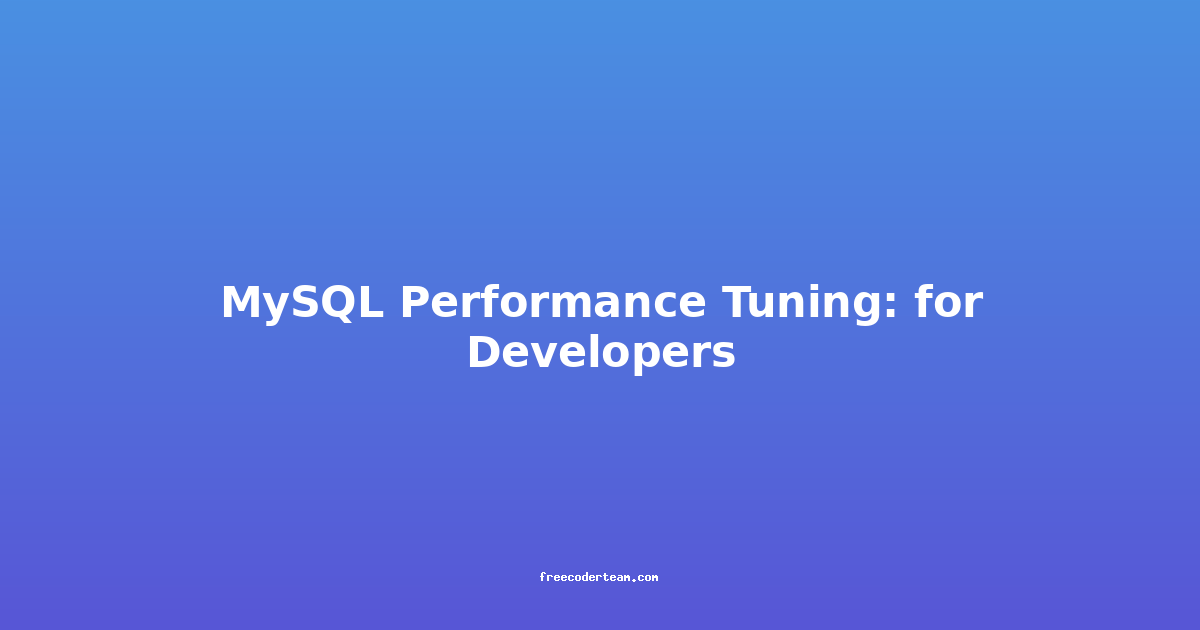Beginner's Guide to Database Indexing Strategies
Database indexing is a fundamental concept in database management systems that can significantly improve query performance. However, it's a topic that often confuses beginners due to its technical nature. In this guide, we'll break down database indexing into digestible chunks, providing practical examples, best practices, and actionable insights to help you understand and implement indexing effectively.
Table of Contents
- What is a Database Index?
- Why Indexing Matters
- Types of Database Indexes
- Best Practices for Indexing
- Practical Examples of Indexing
- Common Mistakes to Avoid
- Conclusion
What is a Database Index?
A database index is a data structure that improves the speed of data retrieval operations in a database. It acts like an "index" in a book, allowing the database to locate specific data without scanning the entire table. Without an index, the database would need to perform a full table scan, which can be slow, especially for large datasets.
How Indexes Work
Imagine you have a table with millions of rows. A query like SELECT * FROM users WHERE email = 'example@example.com'; would require the database to scan every row to find the matching email. With an index on the email column, the database can quickly locate the row (or rows) that match the query by consulting the index first.
Indexes are stored separately from the main table data and are updated automatically when data is inserted, updated, or deleted.
Why Indexing Matters
- Improved Query Performance: Indexes allow the database to find data faster, reducing the time it takes to execute queries.
- Reduced I/O Operations: By minimizing the need for full table scans, indexes reduce the number of disk reads, which can be a major bottleneck.
- Scalability: As your database grows, indexes become even more critical in maintaining performance.
- Cost-Effective: Indexes are more efficient than adding more hardware to improve performance.
However, indexing is not without trade-offs. Creating and maintaining indexes can consume additional storage and slow down write operations (INSERT, UPDATE, DELETE). Therefore, it's essential to use indexing strategically.
Types of Database Indexes
Different types of indexes are designed to optimize specific types of queries. Here are the most common ones:
B-Tree Indexes
B-Tree (Balanced Tree) indexes are the most common and versatile type of index. They allow efficient range queries and are useful for queries involving WHERE, ORDER BY, and JOIN clauses.
Example:
CREATE TABLE users (
id INT PRIMARY KEY,
first_name VARCHAR(50),
last_name VARCHAR(50),
email VARCHAR(100)
);
-- Create a B-Tree index on the email column
CREATE INDEX idx_email ON users(email);
In this example, an index on the email column would speed up queries like:
SELECT * FROM users WHERE email = 'example@example.com';
Hash Indexes
Hash indexes are used for equality comparisons and are very fast for exact matches. However, they don't support range queries or ordering.
Example:
CREATE TABLE users (
id INT PRIMARY KEY,
first_name VARCHAR(50),
last_name VARCHAR(50),
email VARCHAR(100)
);
-- Create a hash index on the email column
CREATE INDEX idx_email_hash ON users(email) USING HASH;
Hash indexes are ideal for queries like:
SELECT * FROM users WHERE email = 'example@example.com';
Full-Text Indexes
Full-text indexes are designed for text-based searches, allowing you to search for keywords within text fields.
Example:
CREATE TABLE articles (
id INT PRIMARY KEY,
title VARCHAR(255),
content TEXT
);
-- Create a full-text index on the content column
CREATE FULLTEXT INDEX idx_content ON articles(content);
With a full-text index, you can perform queries like:
SELECT * FROM articles WHERE MATCH(content) AGAINST('database indexing');
Spatial Indexes
Spatial indexes are used for geographic data, allowing efficient querying of location-based data.
Example:
CREATE TABLE locations (
id INT PRIMARY KEY,
name VARCHAR(100),
location GEOMETRY
);
-- Create a spatial index on the location column
CREATE SPATIAL INDEX idx_location ON locations(location);
Spatial indexes are useful for queries like:
SELECT * FROM locations WHERE ST_CONTAINS(location, POINT(40.7128, -74.0060));
Best Practices for Indexing
-
Index Columns Used in WHERE Clauses: Columns that appear in
WHEREclauses are prime candidates for indexing. For example:CREATE INDEX idx_name ON users(last_name, first_name); -
Covering Indexes: Create indexes that include all columns referenced in a query. This avoids additional lookups.
CREATE INDEX idx_user_details ON users(last_name, first_name, email); -
Avoid Indexing Low-Cardinality Columns: Columns with few unique values (e.g.,
genderwith only 'M' and 'F') are not good candidates for indexing because they don't narrow down the search enough. -
Composite Indexes: Use composite indexes (multi-column indexes) when querying multiple columns together.
CREATE INDEX idx_name_email ON users(last_name, email); -
Monitor Index Usage: Use database tools to identify underutilized or redundant indexes.
-
Consider Data Volume: For small tables, indexes may not provide significant benefits due to the overhead of maintaining them.
-
Regular Maintenance: Rebuild or reorganize indexes periodically to maintain their efficiency.
Practical Examples of Indexing
Example 1: Indexing for a High-Traffic Blog
Imagine you have a blog with millions of posts. Users search for posts by title and date.
CREATE TABLE posts (
id INT PRIMARY KEY,
title VARCHAR(255),
content TEXT,
publish_date DATE
);
-- Index for searching by title
CREATE INDEX idx_title ON posts(title);
-- Index for searching by date range
CREATE INDEX idx_publish_date ON posts(publish_date);
With these indexes, queries like the following will be optimized:
SELECT * FROM posts WHERE title LIKE '%database%';
SELECT * FROM posts WHERE publish_date BETWEEN '2023-01-01' AND '2023-12-31';
Example 2: Optimizing Customer Search in an E-commerce App
In an e-commerce app, you want to quickly find customers by their email or phone number.
CREATE TABLE customers (
id INT PRIMARY KEY,
first_name VARCHAR(50),
last_name VARCHAR(50),
email VARCHAR(100),
phone_number VARCHAR(20)
);
-- Index for email searches
CREATE INDEX idx_email ON customers(email);
-- Index for phone number searches
CREATE INDEX idx_phone_number ON customers(phone_number);
Queries like these will benefit from indexing:
SELECT * FROM customers WHERE email = 'john.doe@example.com';
SELECT * FROM customers WHERE phone_number = '+1234567890';
Common Mistakes to Avoid
- Over-Indexing: Adding too many indexes can slow down write operations and consume excessive storage.
- Ignoring Index Selectivity: Low-cardinality columns (e.g.,
gender) may not benefit from indexing. - Neglecting Index Maintenance: Failing to monitor and maintain indexes can lead to performance degradation.
- Ignoring Composite Indexes: Not leveraging composite indexes can result in missed optimization opportunities.
Conclusion
Database indexing is a powerful tool for optimizing query performance, but it requires careful planning and execution. By understanding the different types of indexes, following best practices, and avoiding common pitfalls, you can significantly improve the efficiency of your database queries.
Remember: Indexing is not a one-size-fits-all solution. Each database and use case is unique, so it's essential to monitor performance and adjust indexing strategies accordingly. With practice, you'll become proficient in identifying when and how to use indexes to their full potential.
Resources for Further Learning:
By mastering indexing, you'll be well on your way to building efficient and high-performing database applications. Happy querying!




